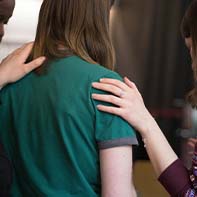Whole Life Worship
Sunday Worship. Monday Life. Sunday by Sunday we gather. The ‘retired-busy’ crowd, the ‘living-life-to-the-full crowd’, the ‘uncertain-in-faith’ cro...
Read
In this blog series, Sam and Sara Hargreaves, co-authors of LICC’s Whole Life Worship resource, explore how the worship we offer in church can shape the way we worship in all the variety of our lives – and how churches can grow a culture that equips people to act, speak, and work in worship, every day of the week.
If we want to lead gathered worship which inspires, equips and sends out our congregations to worship in their scattered lives, we will need to re-think how we approach planning and leading our services. For most of us, the traditions we have inherited (however historic or contemporary) do not easily engage with these topics. Beyond this, there might be a deeper concern that a focus on the world outside the church doors would mean taking our eyes off Jesus.
We want to be clear – you should never intend to distract your congregations from Jesus. However, we do wonder whether sometimes we need to be distracted from a preoccupation with ourselves. Sometimes we need to be reminded that God has a purpose for the whole of creation, the world he so loves, and that he is calling us to play our part in that purpose.
To help us picture this, we have adapted the popular image of church having three dimensions. In applying this to worship, we would say that there is:
A vertical dimension: In worship we hear from God, we sing and pray to him, we receive from God and respond to him. This is vital and irreplaceable, all worship must include this dimension.
A horizontal dimension: In worship we engage with one another within the church. This means singing with and to one another, praying together, encouraging one another, building one another up.
A third dimension: This third dimension is how our Sunday worship relates to the world outside the church doors. Engaging the third dimension means our songs, prayers and actions of gathered worship responding to things like our work, our homes, our communities, the things we see on the news, and the justice issues we care about.
This last one is perhaps the most difficult to include within gathered worship – at least with the models and examples we’ve inherited. But we believe that without this dimension our worship is simply 2D – flat, lacking depth, failing to connect with everyday life.
How you approach the third dimension will depend on what comes naturally in your current style. Some churches sing a lot of songs, so it may be most natural to incorporate some new ones which intentionally focus out (for example, Not Made for the Harbour, Build Your Kingdom Here, Unbroken Praise, God The Maker). More hymn-based congregations might find it easier to use a new text to an existing tune (such as We Seek Your Kingdom to Eventide, or We Are Called To Be God’s People to Austrian Hymn).
Other churches might use set liturgical prayers, and again new texts can be found to point people outward (see this ‘Salt and Light’ sending prayer, or this confession around environmental issues.) If you use visual images in your services, perhaps projected on a screen, it might be helpful to review what kinds of pictures you use. Only displaying nature scenes and religious symbols could reinforce a kind of worship-escapism. In contrast, showing local, urban images, or pictures from the news, or photos taken by your congregation, could add the third dimension in a subtle but powerful way.
—
Sam and Sarah Hargreaves
Engage Worship
